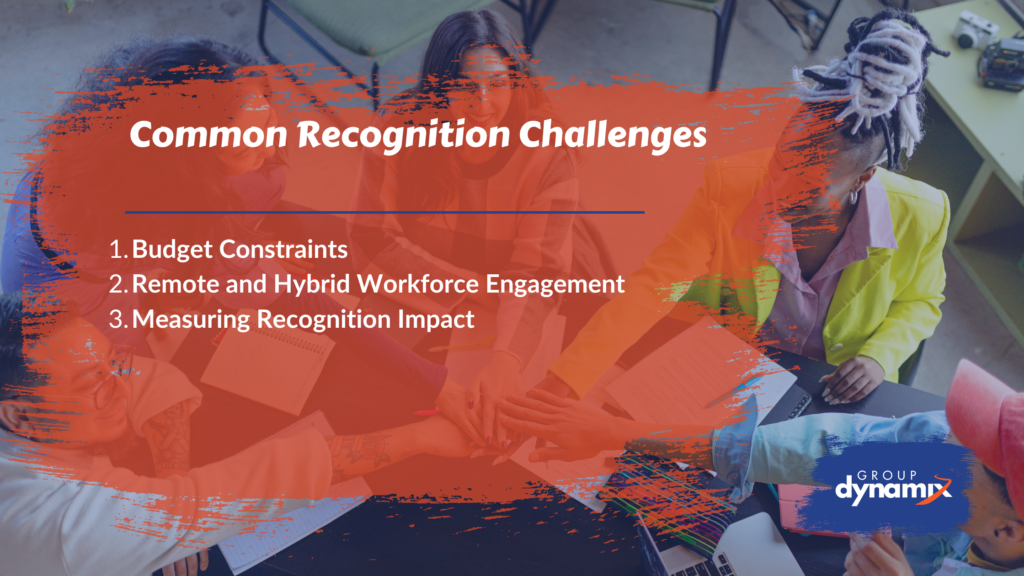Employee appreciation events play a crucial role in reinforcing your organization’s values and culture. By celebrating achievements publicly, you communicate what success looks like at your company, inspiring others to strive toward similar excellence. This alignment with organizational goals creates a virtuous cycle of positive behaviors and outcomes that benefit everyone involved.
Ready to elevate your employee appreciation efforts? Contact Group Dynamix today to plan an unforgettable event that recognizes and motivates your team!
Benefits of Corporate Team Building?
Benefits of Corporate Team Building?
Table of Contents

Employee Appreciation Event Ideas
From budget-friendly options to more elaborate celebrations, these employee appreciation event ideas can help foster a culture of recognition and boost morale across your organization, with real-world implementation guidance and examples from successful companies.
Creative Office Celebrations
Themed Dress-Up Days
Transform ordinary workdays into exciting experiences with themed dress-up days. These simple employee appreciation ideas require minimal preparation but create maximum enjoyment.
Real-World Example: Zappos implements its creative “Wow” recognition culture through themed days that celebrate their playful corporate culture. The company encourages employees to showcase their personalities through costume days linked to their core values, resulting in high employee satisfaction and retention rates.
Implementation Guidance:
- Budget: $10-50 per employee for small prizes and decorations
- Timeline: Announce 2 weeks in advance; schedule quarterly or monthly
- Resources: Internal communication platforms, prize budget, optional themed decorations
- Success Metrics: Participation rates, social media engagement, employee feedback surveys
Office Olympics and Game Days
Transform your workplace into a friendly competition zone with activities like paper airplane contests, desk chair races, or interdepartmental trivia challenges.
Real-World Example: Google regularly incorporates gamification into its employee engagement strategy, including office-wide competitions that foster collaboration across teams. These activities contribute to Google’s recognition as one of the best places to work and support its innovative culture.
Implementation Guidance:
- Budget: $100-500 total for small businesses; $20-50 per employee for larger companies
- Timeline: Plan 3-4 weeks ahead; schedule semi-annually
- Resources: Game supplies, prizes, dedicated planning committee, space allocation
- Success Metrics: Cross-departmental interaction, team feedback, post-event engagement
DIY Art Classes and Workshops
Bringing in local artists or crafters to lead workshops offers employees a chance to develop new skills while relaxing in each other’s company.
Real-World Example: Salesforce’s “Winning as a Team” program includes creative workshops that tie recognition directly to core company values. These sessions not only provide skill development but reinforce organizational culture, contributing to notable engagement and satisfaction increases.
Implementation Guidance:
- Budget: $30-100 per employee depending on materials and instructor fees
- Timeline: Book instructors 4-6 weeks ahead; schedule quarterly
- Resources: Workshop materials, instructor, appropriate space, sign-up system
- Success Metrics: Participation rates, skill application in workplace, stress reduction indicators
Exciting Off-Site Activities
Team-Building Field Trips
Taking the celebration beyond office walls can revitalize team dynamics with shared experiences that strengthen relationships—Group Dynamix is the perfect place to do this.
Real-World Example: The Ritz-Carlton combines off-site experiences with their “First Class Cards” recognition program, where exceptional service is celebrated through immediate peer recognition. These cards are redeemable for various rewards, including team experiences, resulting in high customer satisfaction ratings and lower employee turnover compared to industry averages.
Implementation Guidance:
- Budget: Small companies: $50-150 per person; Mid-sized: $100-250 per person; Enterprise: $200-500+ per person
- Timeline: Plan 6-8 weeks ahead; schedule annually or semi-annually
- Resources: Transportation, activity fees, meals, potential facilitator
- Success Metrics: Team cohesion assessment, knowledge retention, subsequent collaboration quality
Escape Rooms and Adventure Days
For teams that thrive on problem-solving challenges, escape rooms or adventure activities deliver excitement while building critical teamwork skills.
Real-World Example: Salesforce integrates team-based challenge activities into its recognition program, aligning with their “Ohana” culture of appreciation and inclusivity. Teams that successfully complete challenges can direct recognition rewards to charitable causes, reinforcing company values.
Implementation Guidance:
- Budget: $30-100 per employee for escape rooms; $100-300 per employee for adventure experiences
- Timeline: Book 4-6 weeks ahead; ideal for quarterly or project completion celebrations
- Resources: Venue booking, transportation coordination, potential team-building facilitator
- Success Metrics: Problem-solving improvement, cross-functional communication, leadership emergence
Outdoor Picnics and Nature Walks
Organizing company picnics in local parks or guided nature walks provides a refreshing break from office routines and connects teams with nature.
Real-World Example: REI, consistent with its outdoor-focused mission, incorporates regular outdoor team gatherings that combine appreciation with environmental stewardship. These events reinforce the company’s values while providing employees with refreshing experiences away from their usual work environment.
Implementation Guidance:
- Budget: $25-75 per employee, depending on catering and activity options
- Timeline: Plan 3-4 weeks ahead; ideal for seasonal celebrations
- Resources: Location permit, catering or potluck coordination, outdoor games/activities
- Success Metrics: Stress reduction indicators, informal relationship building, return-to-work productivity
Virtual and Remote Employee Appreciation
Online Tribute Videos and Personalized Shoutouts
Creating tribute videos where leaders and colleagues share specific praise about team members can be surprisingly moving for remote teams.
Real-World Example: General Motors successfully launched a global recognition platform that facilitated peer-to-peer recognition across its dispersed workforce. Within 30 days, 87% of GM’s global workforce actively participated, with over 80,000 recognitions sent, demonstrating the power of digital appreciation at scale.
Implementation Guidance:
- Budget: $0-50 per recognition (depending on additional digital rewards)
- Timeline: Establish a regular schedule (weekly/monthly); allow 1 week for video compilation
- Resources: Video editing software, digital tribute template, distribution platform
- Success Metrics: View rates, employee feedback, reciprocal recognition patterns
Virtual Reality Experience Days
Sending VR headsets preloaded with team experiences creates shared adventures despite physical separation.
Real-World Example: While an emerging trend rather than an established case study, technology companies like Microsoft have begun experimenting with VR-based team experiences to connect their globally distributed workforce, finding initial success in creating shared experiences that transcend physical limitations.
Implementation Guidance:
- Budget: $200-500+ per employee, depending on technology requirements
- Timeline: Plan 8-12 weeks ahead to account for equipment procurement and setup
- Resources: VR equipment, experience development or licensing, technical support
- Success Metrics: Participation completion rates, novelty impact, team cohesion metrics
Digital Appreciation Boards
Digital recognition boards where team members publicly acknowledge each other’s contributions create visibility for everyday achievements.
Real-World Example: Google’s “gThanks” program enables employees to give public peer-to-peer recognition visible across the organization. This system is integrated seamlessly into daily workflows and has enhanced collaboration while contributing to building a strong company culture that drives innovation and loyalty.
Implementation Guidance:
- Budget: Software subscription costs typically $5-15 per employee monthly
- Timeline: 4-6 weeks for platform selection and implementation
- Resources:
Recognition platform, initial training, regular content prompts
Success Metrics: Platform engagement, recognition frequency, repeat participation rates

Implementing a Culture of Continuous Recognition
While special events create memorable moments, true employee engagement comes from establishing a consistent culture of appreciation that permeates everyday work life.
Creating an Ongoing Appreciation Program
Sustainable recognition requires structure and consistency rather than sporadic efforts. According to industry benchmarks, companies typically allocate 1-2% of their payroll for recognition programs, with some high-performing organizations reaching up to 10%.
The average annual spend is $275 per employee, although O.C. Tanner recommends $200-$350 per employee annually for meaningful and frequent recognition. Budget allocation should be tailored to company size:
- Small Businesses: $50 to $150 per employee annually
- Mid-Sized Companies: $100 to $500 per employee annually, with total program budgets reaching up to 2% of payroll
- Large Corporations: $500 to $2,000+ per employee annually, with high-performing companies dedicating up to 3% of payroll on recognition
Leadership participation is crucial for program success. As indicated in the Gallup survey, managers proficient in giving positive recognition lead teams with 40% higher engagement rates, demonstrating the importance of training leaders to recognize effectively.
To measure program effectiveness, track key performance indicators including:
- Employee Retention: Compare turnover rates before and after implementation
- Revenue per Employee: Assess productivity improvements
- Engagement Scores: Use eNPS (Employee Net Promoter Score) to track engagement trends
- Feedback Surveys: Gather qualitative insights on program impact
Integrating Work-Life Balance into Appreciation Efforts
True appreciation extends beyond acknowledging work outputs to honoring employees as whole people with lives outside the office.
Flexible Scheduling Options
One of the most valued forms of recognition is offering flexibility that helps employees manage their personal and professional responsibilities more effectively.
Real-World Example: Salesforce’s flexibility-focused appreciation initiatives have strengthened their organizational culture and encouraged employee advocacy. Their approach to work-life balance includes no-meeting days and flexible scheduling options, contributing to their reputation as a top employer.
Implementation Guidance:
- Budget: Minimal direct costs; potential productivity monitoring software ($5-20 per employee monthly)
- Timeline: Pilot with select teams for 3 months before full implementation
- Resources: Clear policy documentation, manager training, performance evaluation adjustments
- Success Metrics: Productivity metrics, work satisfaction scores, burnout indicators
Wellness and Mental Health Support
Among the most impactful employee appreciation activities are those supporting holistic wellbeing.
Real-World Example: Google’s wellness program includes mental health resources and support services as part of their comprehensive employee appreciation strategy. This investment in employee wellbeing contributes to their strong retention rates and workplace satisfaction scores.
Implementation Guidance:
- Budget: Small companies: $50-150 per employee annually; Mid-sized: $100-300; Enterprise: $200-500+
- Timeline: Develop quarterly wellness initiatives with continuous access to resources
- Resources: Wellness platform or services, educational materials, dedicated coordination team
Success Metrics: Program utilization rates, health risk assessment trends, absenteeism reduction

Addressing Common Recognition Challenges
Budget Constraints
Small and medium-sized businesses often face resource limitations when implementing recognition programs. To overcome this challenge:
- Focus on high-impact, low-cost recognition: Handwritten notes from executives, public recognition in team meetings, and featured employee spotlights on company channels cost little but deliver significant impact.
- Create tiered recognition systems: Implement daily peer recognition, monthly manager acknowledgments, and quarterly leadership awards to spread budget effectively.
- Leverage partner relationships: Negotiate special employee discounts or experiences with business partners and vendors as recognition rewards.
Remote and Hybrid Workforce Engagement
With distributed teams becoming the norm, ensuring equitable recognition poses unique challenges:
- Implement technology solutions: Utilize platforms like Bonusly, Kudos, or Recognize that integrate with existing workflow tools to make appreciation accessible regardless of location.
- Create virtual-first experiences: Design recognition events that are equally engaging for in-person and remote participants, avoiding second-class experiences for remote team members.
- Send physical tokens to digital spaces: Complement virtual recognition with tangible items mailed to remote employees’ homes, creating a physical connection to the appreciation experience.
Measuring Recognition Impact
Demonstrating ROI for recognition initiatives often challenges program administrators:
- Establish clear baseline metrics: Before launching or enhancing recognition programs, document current engagement scores, turnover rates, and productivity metrics.
- Implement regular pulse surveys: Use brief, frequent surveys to gauge employee sentiment about recognition specifically, rather than waiting for annual engagement surveys.
Track specific business outcomes: Monitor customer satisfaction, error rates, and innovation metrics alongside recognition program activity to identify correlations.
Engaging Company Events
Corporate Events, Group Outings, Private Events, Charities, Meetings, and More...
Engaging Company Events
Corporate Events, Group Outings, Private Events, Charities, Meetings, and More...
Conclusion: Building a Thriving Workplace through Appreciation
By making appreciation a cornerstone of your organizational culture rather than an occasional afterthought, you build a workplace where people feel genuinely valued for their complete contributions—professionally and personally. This foundation of respect and recognition ultimately creates the thriving, resilient organization that can navigate challenges, seize opportunities, and sustain success through changing times.
Ready to transform your workplace culture? At Group Dynamix, we specialize in creating engaging team-building experiences that foster appreciation and recognition among your team members. Let us help you elevate your organization to new heights. Contact us today to learn more about our programs and start cultivating a culture of appreciation that empowers your employees and enhances your business success!

